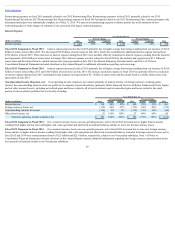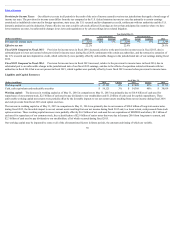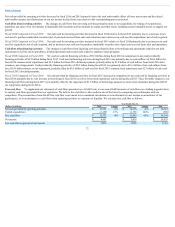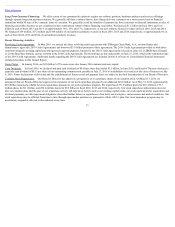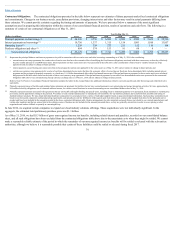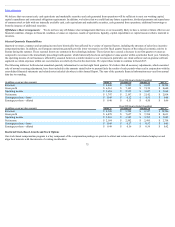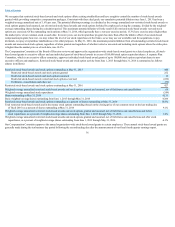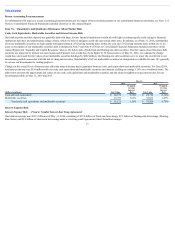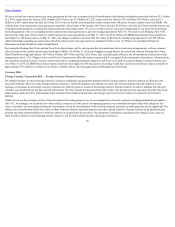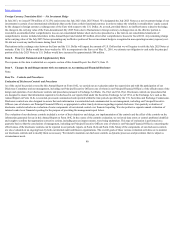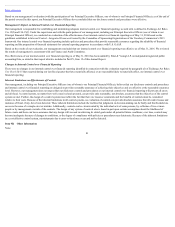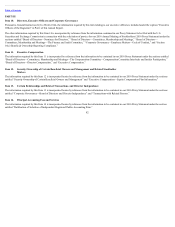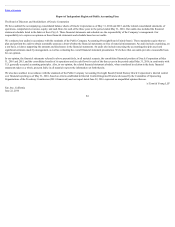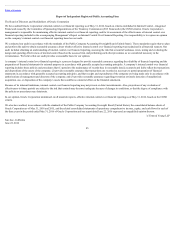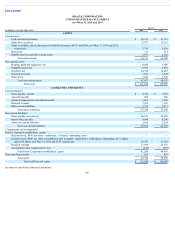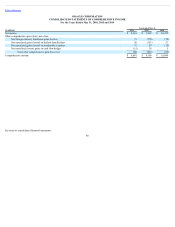Oracle 2015 Annual Report Download - page 80
Download and view the complete annual report
Please find page 80 of the 2015 Oracle annual report below. You can navigate through the pages in the report by either clicking on the pages listed below, or by using the keyword search tool below to find specific information within the annual report.
Table of Contents
We have entered into certain interest rate swap agreements that have the economic effect of modifying the fixed-interest obligations associated with our $1.5 billion
of 2.375% senior notes due January 2019 (January 2019 Notes), our $2.0 billion of 2.25% senior notes due October 2019 (October 2019 Notes), and our $1.5
billion of 2.80% senior notes due July 2021 (July 2021 Notes) so that the interest payable on these senior notes effectively became variable based on LIBOR. The
critical terms of the interest rate swap agreements match the critical terms of the January 2019 Notes, October 2019 Notes, and July 2021 Notes that the interest rate
swap agreements pertain to, including the notional amounts and maturity dates. We do not use these interest rate swap arrangements or our fixed-rate borrowings
for trading purposes. We are accounting for these interest rate swap agreements as fair value hedges pursuant to ASC 815, DerivativesandHedging(ASC 815).
The total fair value gain of these fixed to variable interest rate swap agreements as of May 31, 2016 was $122 million. If LIBOR-based interest rates would have
been higher by 100 basis points as of May 31, 2016, the change would have decreased the fair values of the fixed to variable swap agreements by $185 million.
Additional details regarding our senior notes and related interest rate swap agreements are included in Notes 8 and 11 of Notes to Consolidated Financial
Statements included elsewhere in this Annual Report.
By issuing the Floating-Rate Notes and the Short-Term Borrowings, and by entering into the aforementioned interest rate swap arrangements, we have assumed
risks associated with variable interest rates based upon LIBOR. As of May 31, 2016, the weighted-average interest rate associated with our Floating-Rate Notes,
Short-Term Borrowings and January 2019 Notes, October 2019 Notes and July 2021 Notes, after considering the effects of the aforementioned interest rate swap
arrangements, was 1.14%. Changes in the overall level of interest rates affect the interest expense that we recognize in our statements of operations. An interest rate
risk sensitivity analysis is used to measure interest rate risk by computing estimated changes in cash flows as a result of assumed changes in market interest rates.
As of May 31, 2016, if LIBOR-based interest rates would have been higher by 100 basis points, the change would have increased our interest expense annually by
approximately $76 million as it relates to our fixed to variable interest rate swap agreements and floating-rate borrowings.
Currency Risk
Foreign Currency Transaction Risk — Foreign Currency Forward Contracts
We transact business in various foreign currencies and have established a program that primarily utilizes foreign currency forward contracts to offset the risks
associated with the effects of certain foreign currency exposures. Under this program, our strategy is to enter into foreign currency forward contracts so that
increases or decreases in our foreign currency exposures are offset by gains or losses on the foreign currency forward contracts in order to mitigate the risks and
volatility associated with our foreign currency transactions. We may suspend this program from time to time. Our foreign currency exposures typically arise from
intercompany sublicense fees, intercompany loans and other intercompany transactions. Our foreign currency forward contracts are generally short-term in
duration.
Neither do we use these foreign currency forward contracts for trading purposes nor do we designate these forward contracts as hedging instruments pursuant to
ASC 815. Accordingly, we record the fair values of these contracts as of the end of our reporting period to our consolidated balance sheet with changes in fair
values recorded to our consolidated statement of operations. Given the short duration of the forward contracts, amounts recorded generally are not significant. The
balance sheet classification for the fair values of these forward contracts is prepaid expenses and other current assets for forward contracts in an unrealized gain
position and other current liabilities for forward contracts in an unrealized loss position. The statement of operations classification for changes in fair values of
these forward contracts is non-operating income (expense), net for both realized and unrealized gains and losses.
78



